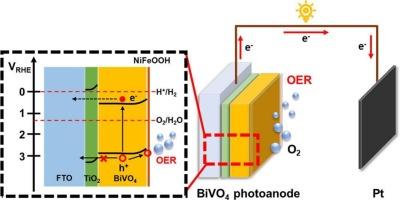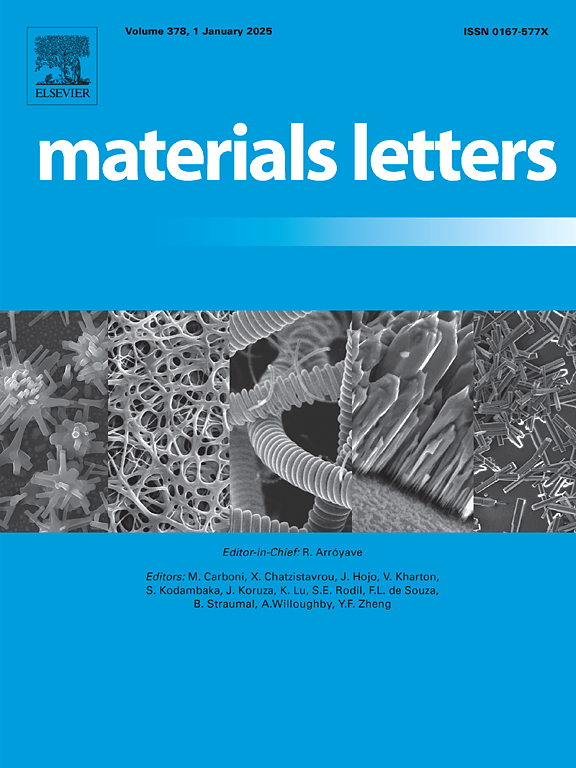Interfacial Engineering of FTO/TiO2 Bilayer for Improved charge separation in BiVO4 photoanodes
IF 2.7
4区 材料科学
Q3 MATERIALS SCIENCE, MULTIDISCIPLINARY
引用次数: 0
Abstract
To advance next-generation photoanodes for solar-driven water splitting, innovative strategies to enhance surface catalysis and charge transport are essential. Among various photoanode materials, bismuth vanadate (BiVO4) stands out as a promising candidate not only for enhanced photoelectrochemical (PEC) performance but also for being eco-friendly. Herein, a TiO2 underlayer was deposited on fluorine-doped tin oxide (FTO) substrates to fabricate FTO/TiO2/BiVO4 heterojunctions, thereby enhancing the electrical properties of the photoanode. Additionally, the simplest Fenton-like deposition method was employed to deposit NiFeOOH overlayer on BiVO4. As a result, the FTO/TiO2/BiVO4/NiFeOOH photoanode achieved the remarkable photocurrent density of 1.73 mA/cm2 and ABPE(%) of 0.432 %. These findings demonstrate that the TiO2 underlayer significantly increases the charge transport by suppressing surface recombination, thereby advancing the PEC performance of BiVO4-based photoanode.

改善BiVO4光阳极电荷分离的FTO/TiO2双分子层界面工程
为了推进用于太阳能驱动水分解的下一代光阳极,提高表面催化和电荷传输的创新策略是必不可少的。在各种光阳极材料中,钒酸铋(BiVO4)不仅具有增强的光电化学(PEC)性能,而且具有生态友好性。在氟掺杂氧化锡(FTO)衬底上沉积TiO2衬底,制备FTO/TiO2/BiVO4异质结,从而提高光阳极的电学性能。此外,采用最简单的类芬顿沉积法在BiVO4上沉积了NiFeOOH覆盖层。结果表明,FTO/TiO2/BiVO4/NiFeOOH光阳极的光电流密度为1.73 mA/cm2, ABPE(%)为0.432%。这些发现表明,TiO2底层通过抑制表面复合显著增加电荷输运,从而提高了bivo4基光阳极的PEC性能。
本文章由计算机程序翻译,如有差异,请以英文原文为准。
求助全文
约1分钟内获得全文
求助全文
来源期刊

Materials Letters
工程技术-材料科学:综合
CiteScore
5.60
自引率
3.30%
发文量
1948
审稿时长
50 days
期刊介绍:
Materials Letters has an open access mirror journal Materials Letters: X, sharing the same aims and scope, editorial team, submission system and rigorous peer review.
Materials Letters is dedicated to publishing novel, cutting edge reports of broad interest to the materials community. The journal provides a forum for materials scientists and engineers, physicists, and chemists to rapidly communicate on the most important topics in the field of materials.
Contributions include, but are not limited to, a variety of topics such as:
• Materials - Metals and alloys, amorphous solids, ceramics, composites, polymers, semiconductors
• Applications - Structural, opto-electronic, magnetic, medical, MEMS, sensors, smart
• Characterization - Analytical, microscopy, scanning probes, nanoscopic, optical, electrical, magnetic, acoustic, spectroscopic, diffraction
• Novel Materials - Micro and nanostructures (nanowires, nanotubes, nanoparticles), nanocomposites, thin films, superlattices, quantum dots.
• Processing - Crystal growth, thin film processing, sol-gel processing, mechanical processing, assembly, nanocrystalline processing.
• Properties - Mechanical, magnetic, optical, electrical, ferroelectric, thermal, interfacial, transport, thermodynamic
• Synthesis - Quenching, solid state, solidification, solution synthesis, vapor deposition, high pressure, explosive
 求助内容:
求助内容: 应助结果提醒方式:
应助结果提醒方式:


